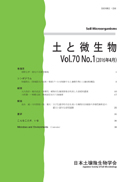Volume 55, Issue 1
Displaying 1-16 of 16 articles from this issue
- |<
- <
- 1
- >
- >|
-
Article type: Article
2001 Volume 55 Issue 1 Pages 1-2
Published: April 01, 2001
Released on J-STAGE: May 31, 2017
Download PDF (354K) -
Article type: Article
2001 Volume 55 Issue 1 Pages 3-10
Published: April 01, 2001
Released on J-STAGE: May 31, 2017
Download PDF (611K) -
Article type: Article
2001 Volume 55 Issue 1 Pages 11-20
Published: April 01, 2001
Released on J-STAGE: May 31, 2017
Download PDF (1080K) -
Article type: Article
2001 Volume 55 Issue 1 Pages 21-27
Published: April 01, 2001
Released on J-STAGE: May 31, 2017
Download PDF (765K) -
Article type: Article
2001 Volume 55 Issue 1 Pages 29-36
Published: April 01, 2001
Released on J-STAGE: May 31, 2017
Download PDF (616K) -
Article type: Article
2001 Volume 55 Issue 1 Pages 37-44
Published: April 01, 2001
Released on J-STAGE: May 31, 2017
Download PDF (839K) -
Article type: Article
2001 Volume 55 Issue 1 Pages 45-53
Published: April 01, 2001
Released on J-STAGE: May 31, 2017
Download PDF (937K) -
Article type: Article
2001 Volume 55 Issue 1 Pages 55-63
Published: April 01, 2001
Released on J-STAGE: May 31, 2017
Download PDF (1000K) -
Article type: Article
2001 Volume 55 Issue 1 Pages 65-
Published: April 01, 2001
Released on J-STAGE: May 31, 2017
Download PDF (312K) -
Article type: Article
2001 Volume 55 Issue 1 Pages 66-67
Published: April 01, 2001
Released on J-STAGE: May 31, 2017
Download PDF (330K) -
Article type: Article
2001 Volume 55 Issue 1 Pages 67-
Published: April 01, 2001
Released on J-STAGE: May 31, 2017
Download PDF (195K) -
Article type: Article
2001 Volume 55 Issue 1 Pages 68-
Published: April 01, 2001
Released on J-STAGE: May 31, 2017
Download PDF (189K) -
Article type: Article
2001 Volume 55 Issue 1 Pages 68-69
Published: April 01, 2001
Released on J-STAGE: May 31, 2017
Download PDF (329K) -
Article type: Article
2001 Volume 55 Issue 1 Pages 69-70
Published: April 01, 2001
Released on J-STAGE: May 31, 2017
Download PDF (309K) -
Article type: Article
2001 Volume 55 Issue 1 Pages 70-71
Published: April 01, 2001
Released on J-STAGE: May 31, 2017
Download PDF (342K) -
Article type: Article
2001 Volume 55 Issue 1 Pages 71-72
Published: April 01, 2001
Released on J-STAGE: May 31, 2017
Download PDF (218K)
- |<
- <
- 1
- >
- >|
